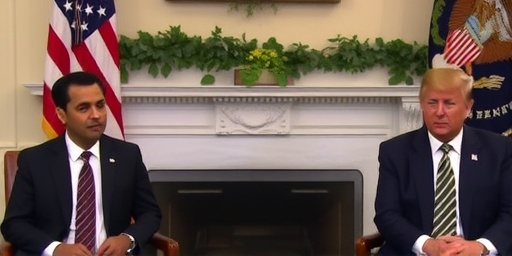In a stunning turn of events that has Washington and New York buzzing, New York City Mayor-elect Zohran Mamdani stepped into the Oval Office today for a historic meeting with President Donald Trump. The two leaders, long at odds over political ideologies, pledged a groundbreaking commitment to collaborate on tackling crime and affordability crises plaguing the Big Apple. This face-to-face encounter marks a pivotal shift, as Mamdani, a progressive firebrand, and Trump, the conservative powerhouse, set aside differences to address urgent urban challenges.
- Mamdani’s Journey from Assembly to Mayor-Elect: Bridging Divides
- Trump’s Oval Office Play: Extending Law-and-Order Reach to NYC
- Crime Wave in New York City: Data-Driven Strategies Take Center Stage
- Affordability Overhaul: Federal Funds Target NYC’s Housing Crunch
- Public Backlash and Bipartisan Hopes: Reactions Pour In
- Path Forward: Implementation Timeline and Long-Term Vision
The meeting, which lasted over an hour, focused on practical solutions rather than partisan rhetoric. Sources close to the discussion revealed that both men emphasized the human cost of rising crime rates and skyrocketing living expenses in New York City, vowing to leverage federal resources for tangible relief. “New Yorkers deserve action, not excuses,” Mamdani stated post-meeting, his words echoing the urgency felt by millions.
This development comes at a critical juncture for NYC, where violent crime has surged by 15% in the past year according to NYPD statistics, and housing affordability has hit rock bottom with median rents climbing to $3,500 monthly. Trump’s administration, fresh off midterm gains, sees this as an opportunity to extend its law-and-order agenda into Democratic strongholds.
Mamdani’s Journey from Assembly to Mayor-Elect: Bridging Divides
Zohran Mamdani‘s rise to mayor-elect has been nothing short of meteoric. Born in Uganda to Indian parents and raised in New York City, the 32-year-old democratic socialist entered politics as a state assembly member in 2020, championing causes like affordable housing and police reform. His upset victory in the mayoral race last month, defeating a field of establishment candidates, was powered by a youth-driven coalition frustrated with the status quo.
Yet, Mamdani’s path hasn’t been without controversy. He has publicly criticized Trump on issues ranging from immigration policies to federal funding cuts for urban programs. In 2022, Mamdani led protests against what he called Trump’s “assault on New York City’s soul,” particularly after the president suggested withholding aid from “anarchist jurisdictions” like NYC during the height of Black Lives Matter demonstrations.
Despite this history, Mamdani’s outreach to Trump underscores a pragmatic evolution. “Politics is about results, not grudges,” he told reporters en route to Washington. Insiders say the meeting was initiated by Mamdani himself, a bold move to secure federal backing for his agenda. This isn’t just diplomacy; it’s a calculated play to deliver on campaign promises amid a city reeling from post-pandemic economic woes.
Statistics paint a grim picture of the stakes. The U.S. Census Bureau reports that 40% of New York City households spend over 30% of their income on rent, exacerbating homelessness rates that have jumped 20% since 2020. Mamdani’s platform, which includes rent freezes and expanded public housing, now hinges on federal partnerships to succeed.
Trump’s Oval Office Play: Extending Law-and-Order Reach to NYC
President Donald Trump, ever the dealmaker, welcomed Mamdani with his signature blend of bravado and business acumen. Flanked by key advisors including Homeland Security Secretary Kristi Noem and Commerce Secretary Wilbur Ross, Trump used the meeting to tout his administration’s successes in curbing national crime trends. Federal data from the FBI shows a 7% drop in violent crime nationwide under Trump’s watch, a statistic he repeatedly highlighted.
“Zohran and I may not see eye to eye on everything, but on keeping New York safe and affordable, we’re aligned,” Trump declared in a brief statement from the Rose Garden. He pledged to fast-track $500 million in federal grants for NYC police modernization, including advanced surveillance tech and community policing initiatives. This comes as Trump ramps up his 2024 re-election narrative, positioning himself as the defender of American cities against “radical left” policies.
The affordability angle was equally emphasized. Trump proposed tax incentives for developers to build mixed-income housing in NYC, drawing from his real estate background. “I’ve built in New York; I know what works,” he quipped, referencing his Trump Tower legacy. Critics, however, question the sincerity, pointing to Trump’s past attempts to slash HUD funding, which disproportionately affected urban poor communities.
Behind the scenes, the meeting touched on immigration enforcement, a flashpoint for both. Mamdani, whose family immigrated legally, pushed for humane reforms, while Trump insisted on stricter border controls to reduce strain on city resources. Yet, the tone remained cooperative, with aides noting Trump’s praise for Mamdani’s “energy and smarts.”
Crime Wave in New York City: Data-Driven Strategies Take Center Stage
New York City’s crime crisis has dominated headlines, with subway slashings up 30% and gun violence spiking in neighborhoods like the Bronx and East Harlem. NYPD Commissioner Jessica Tisch reported over 1,200 shootings in 2023 alone, a stark reminder of the city’s vulnerabilities. Mamdani and Trump zeroed in on this, agreeing to a joint task force blending federal agents with local officers.
“Crime doesn’t care about party lines,” Mamdani said, quoting a line from his campaign stump speech. The duo discussed deploying National Guard units for high-risk areas, a Trump hallmark from his first term, while incorporating Mamdani’s focus on mental health interventions and youth programs. Preliminary plans include $200 million for after-school initiatives targeting at-risk teens, funded through the Department of Justice.
Experts weigh in positively. Dr. Elena Vasquez, a criminologist at NYU, noted, “This bipartisan approach could be transformative. Historical data shows federal-local partnerships reduce recidivism by up to 25%.” Yet, challenges loom: union resistance to federal oversight and concerns over civil liberties in surveillance-heavy plans.
Anecdotal stories underscore the urgency. Take Maria Gonzalez, a Bronx mother whose son was caught in a gang crossfire last year. “We need real help, not more talk,” she shared in a recent interview. Such voices likely influenced the leaders’ resolve, as they reviewed maps of hotspots during the meeting.
Broader context reveals NYC’s unique position. As the nation’s financial hub, the city contributes $1.7 trillion to the U.S. GDP annually, per the Partnership for New York City. A safer, more affordable NYC bolsters national recovery, making this collaboration a win for Trump’s economic agenda.
Affordability Overhaul: Federal Funds Target NYC’s Housing Crunch
The affordability scourge in New York City is as old as the skyline itself, but recent inflation has amplified it. Grocery prices have risen 12% year-over-year, and utility costs are at all-time highs, squeezing middle-class families. Mamdani, a vocal advocate for universal rent control, found common ground with Trump on subsidies for low-income renters.
The president committed to expanding Section 8 vouchers by 50,000 units for NYC, a move that could house 150,000 residents. “We’re going to make New York affordable again,” Trump proclaimed, echoing his campaign slogan. Mamdani reciprocated by endorsing streamlined permitting for affordable developments, potentially unlocking 10,000 new units by 2025.
Quotes from stakeholders highlight the impact. NYC Housing Authority Chair Shola Olatoye stated, “This infusion of federal support is a game-changer for families on waiting lists.” Economists estimate that stabilizing housing could add $50 billion to the local economy through reduced evictions and increased workforce participation.
However, past political clashes cast shadows. Trump’s 2017 tax reform capped state and local deductions, hitting high-tax NYC hard and prompting Mamdani to label it “economic sabotage.” Today’s pledges suggest a thaw, but implementation will test the alliance. Community groups like the Housing Justice for All coalition are optimistic yet vigilant, planning oversight committees to ensure equitable distribution.
Demographic shifts add layers: NYC’s population dipped 3% post-COVID, with young professionals fleeing to cheaper suburbs. Retaining talent requires bold action, which this meeting promises.
Public Backlash and Bipartisan Hopes: Reactions Pour In
The meeting elicited a spectrum of responses. Progressive allies of Mamdani, including Rep. Alexandria Ocasio-Cortez, expressed cautious support: “If it delivers for working New Yorkers, I’m all in—but no compromises on core values.” On the right, Trump’s base cheered the outreach, with Fox News host Sean Hannity calling it “a masterstroke against sanctuary city nonsense.”
Polls reflect divided sentiments. A Siena College survey shows 55% of New Yorkers approve of federal aid for crime but only 42% trust Trump-led initiatives. Business leaders, via the NYC Chamber of Commerce, hailed the talks, predicting a boost in tourism and investment.
Civil rights advocates remain wary. The ACLU warned against “overreach in policing,” urging transparency in task force operations. Meanwhile, everyday New Yorkers shared relief on social media: #NYCSafeAgain trended, with users posting stories of personal encounters with crime.
Path Forward: Implementation Timeline and Long-Term Vision
As the dust settles, the real work begins. Mamdani and Trump outlined a 90-day action plan: pilot programs for crime hotspots launching in January, followed by affordability grants in Q2. Joint press conferences and progress reports will keep momentum alive.
Looking ahead, this partnership could redefine federal-city relations. If successful, it might inspire similar collaborations in Chicago and Los Angeles, addressing national urban decay. For Mamdani, delivering on these pledges cements his legacy; for Trump, it burnishes his statesman image.
Ultimately, New York City’s resilience hangs in the balance. With crime and affordability at the forefront, this unlikely duo’s cooperation offers hope amid division. Watch for updates as policies roll out—New Yorkers, and the nation, are counting on it.









